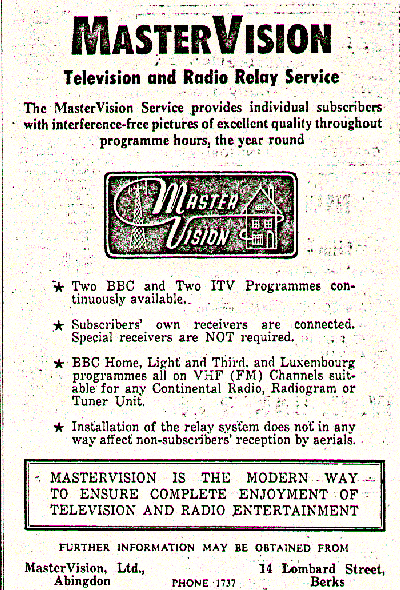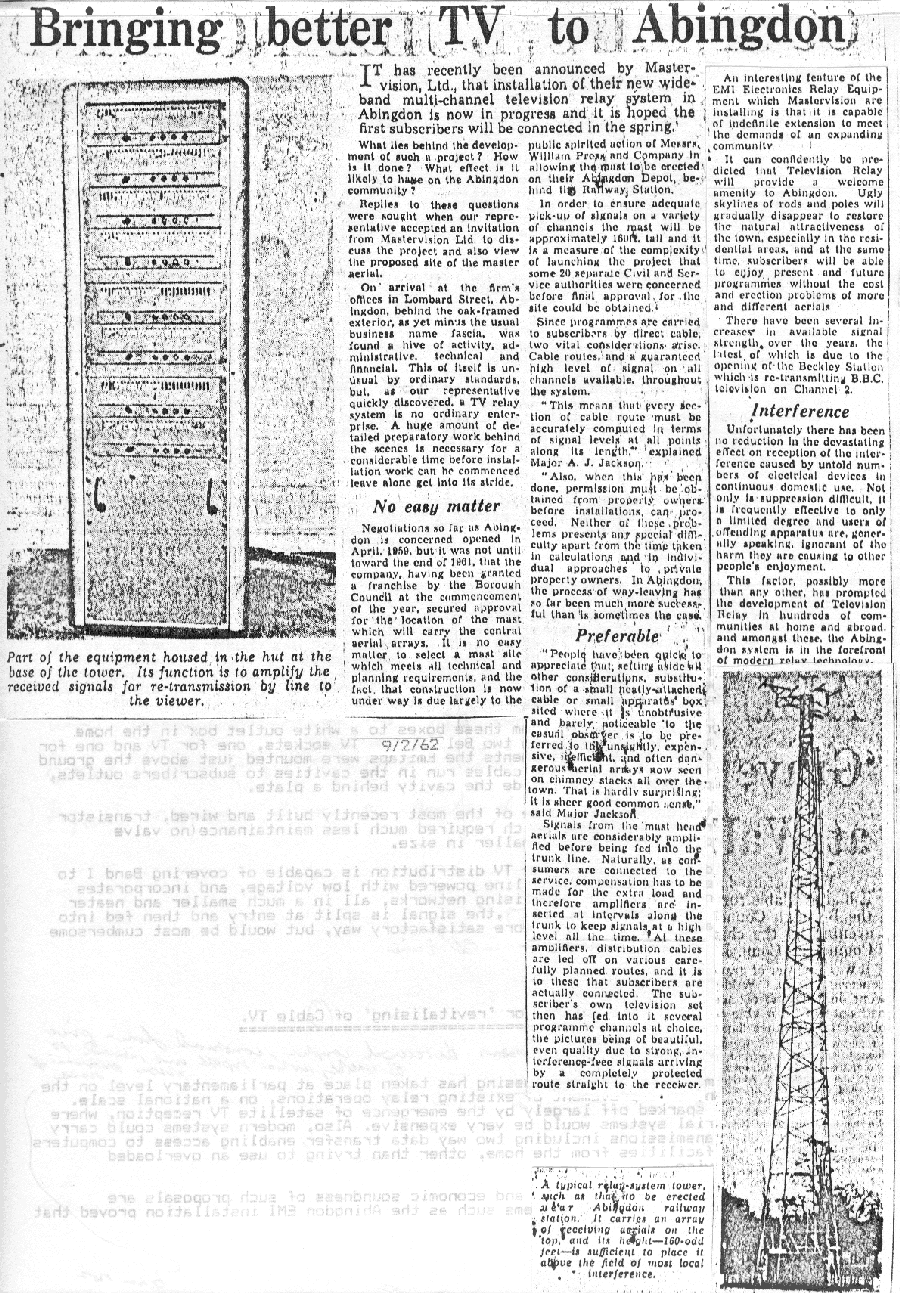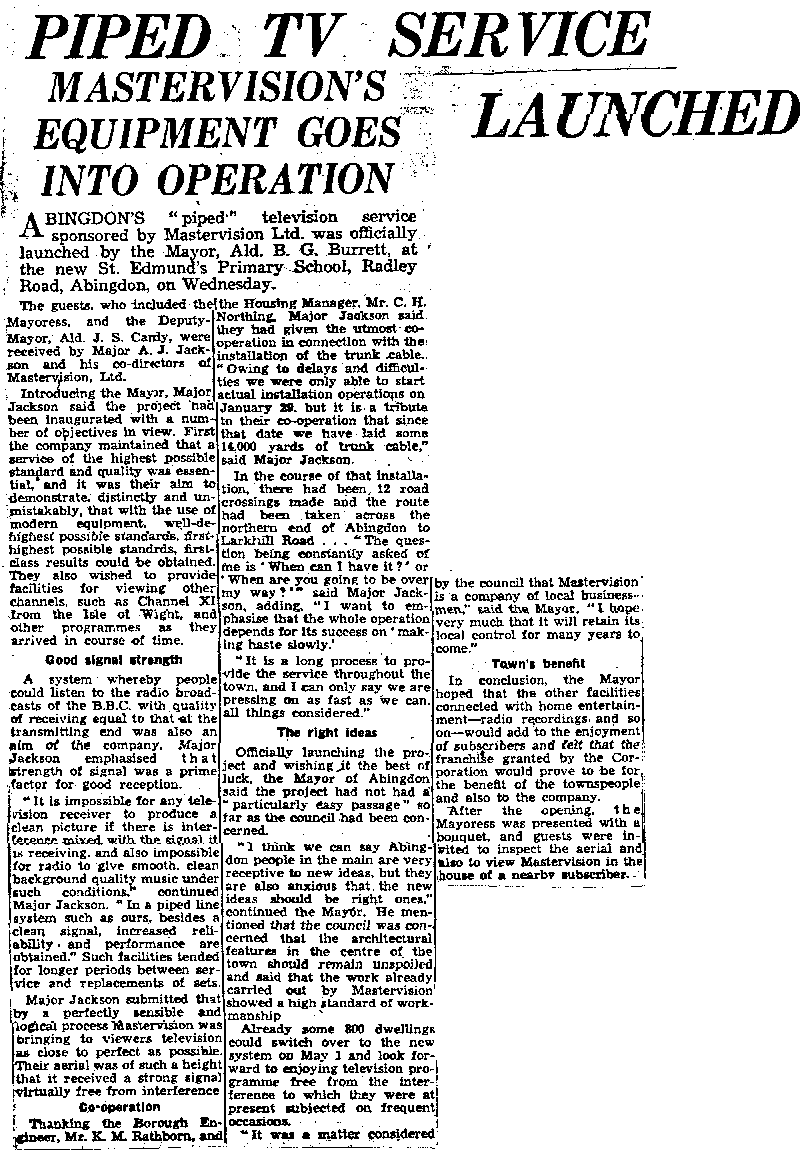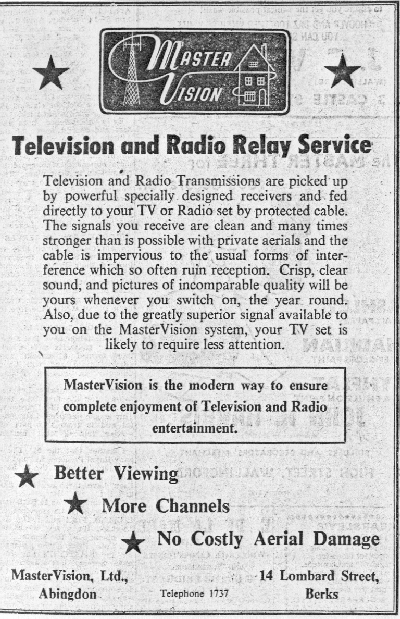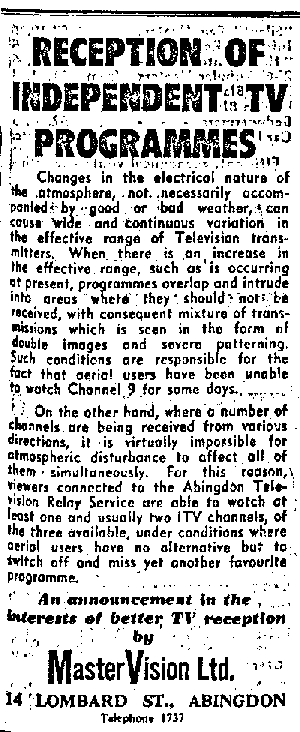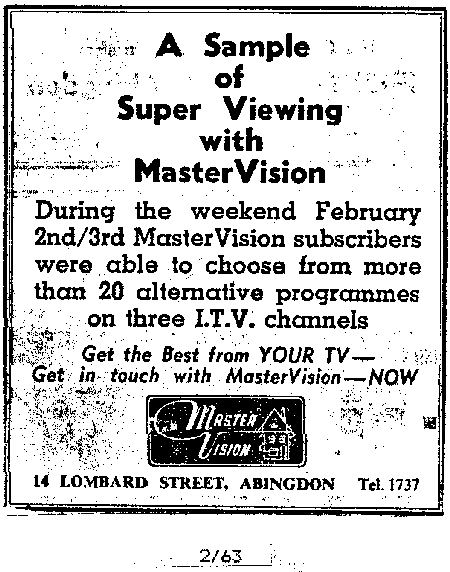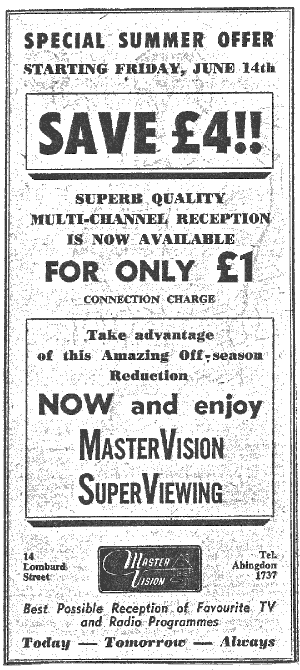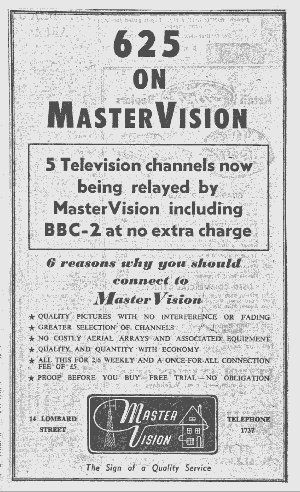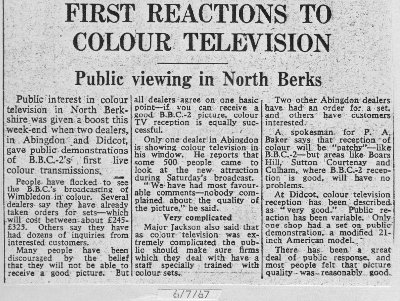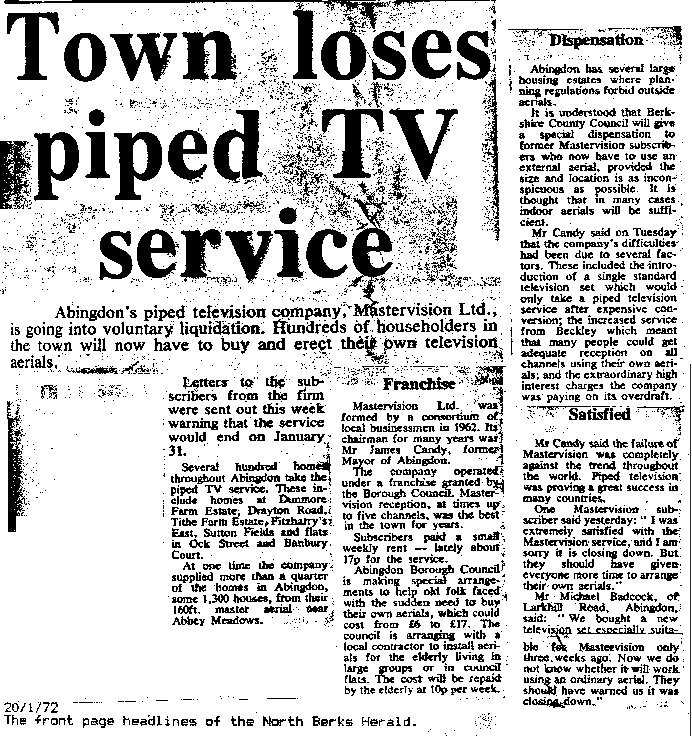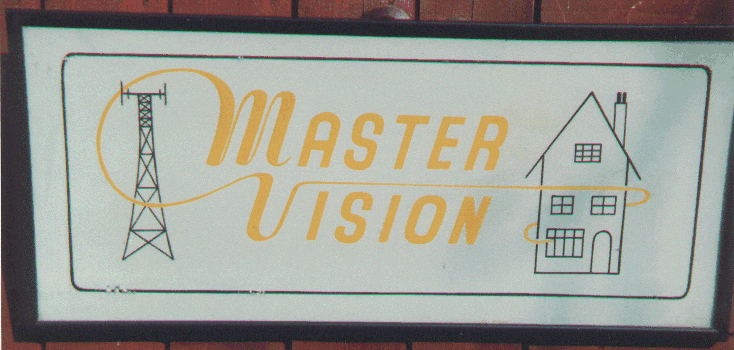
Mastervision Ltd

A brief history of Abingdon's cable TV.
Martin
1982
INTRODUCTION
What follows was written in 1982 as part of a personal research project. Now, nearly some 20 years later, it can be published for the first time, via the Internet. There are two parts, the general history, and the technical description. The script was written back in 1982 on an Apple IIe computer using the Zardax word processor, from which it has been converted to a text file. The English style is not of the standard I write now, but I hope this will not detract from it's interest. Most of the original figures have been scanned and are available by clicking on their references. Some of the original photocopying, done 20 years ago when copiers were not so efficient as they are today, may lead to some problems in scanning. I hope that this does not detract too much from the message they convey.
To the average shopper or householder in Abingdon, cable television is, at most, no more than the odd mysterious box on a wall, or a piece of trailing cable, long since broken. However, to the knowing eye, there is a considerable amount of cable and equipment still located throughout the town. This industrial archaeological communication network represents a considerable number of man hours in setting up and maintenance, spaced over more than 10 years, which is now, 10 years from closure, nearly forgotten.
Take the case of the lady who approached me while I was examining an old amplifier kiosk somewhere in Abingdon recently. "Why have you put that there?", she asked. "Sorry?", I said, not sure what she meant. "That", she said, looking at the very rusty green cabinet in the verge opposite her house. "That's been there for at least 15 years" I said to her. "Good heavens", came the reply, "I have never noticed that before, and I have lived here for 20 years". When I left her she was still puzzled as to why it had to be there, and was threatening war on the council to have it moved.
To look back on one day in 1970, there were over 7 miles of cable, distributing 8 channels of television and radio, to 1300 homes in Abingdon, via more than 60 repeater amplifiers, through 800 hundred glowing valves. Down by the mill stream to the east of the town, still clearly visible today, although used for other purposes, is the 165ft aerial tower which supported the source aerials(fig 1). At the foot was a small hut which housed the amplifier equipment and other devices needed to feed the signals down the trunk cable to the distribution areas around the town.
Trunk cables were run under roads and paths through the town, and connected at intervals to amplifiers, which fed the cable running from house to house, often along the eaves of the buildings, off which subscribers tapped off cable to their aerial sockets. Small wall boxes or roadside kiosks housed the amplifiers needed to maintain the required signal levels.
Now the story behind this achievement can be told before it is forgotten forever.....
It should however be understood that much of the material in this work, particularly that of a technical nature, is the result of observation and deduction by the author, on various 'cable seeking' expeditions, combined with the theory from Gordon King's book, "Communal Aerials and Coaxial Relay Practice". May I apologise in advance for any errors or omissions, and I will be glad to receive any further clarification from readers on any point concerning Mastervision.
The advantages of cable TV.
There were three main advantages of cable TV. Firstly, Abingdon was, at the time, over 50 miles from the nearest available transmitter which was in London. Large aerials were needed on roof-tops, to obtain reasonable signals. Even so, interference from aircraft and road traffic, and other electrical interference from such an urban district, would at times severely disturb, if not wipe out the relatively weak signals available.
These aerials on individual roof-tops, would in simplest form be of an 'H' shape, some 10 feet high by 5 feet long, which is no small structure for a chimney top. For those ambitious enough to try to pick up ITV signals from London, more complicated smaller arrays were added. It was clearly a good case in the view of most people who disapproved of this hairy skyline to be able to avoid the aerials and have a small 'washing-line' cable instead.
It was indeed the very aesthetics of avoiding the roof-top jungle that were used to sell cable TV in the early sixties, as EMI's adverts clearly show(fig 2). Mastervision used a display in their shop window to compare streets with and without aerials.
Secondly, prompted from the bad signals mentioned above, which people tolerated for their TV reception, cable TV offered an interference free, near perfect strong signal at each TV aerial socket,(barring system failures of course which were not unheard of. Your own aerial is not as likely to fail so often as a complex cable system). One fairly common hazard to reception was road works which could cause cable faults at any time, affecting anyone from just a few houses to the whole of one half of the system. Power failure in south Abingdon would mean no TV for anyone using the system. However a system fault is not likely to last as long as, for example, a customers own set failing and televisions were not so reliable then as they are now.
The third advantage, which is in a way a by product, was the availability of extra channels other than London BBC1 and ITV. Since a fairly high aerial was used to obtain the good signals required for the system from London, other transmitters, although slightly farther away and therefore offering slightly less signal, could be received adequately too. These included ITV programmes from Isle of Wight and from Lichfield, north of Birmingham.
Since a wideband system was used a number of channels could be 'retransmitted' down the cable simultaneously. Consumer's TV sets usually needed no modifications to receive 405 line transmissions. Cable signals were distributed at or near the same frequency, and therefore the cable would, to the TV set, 'look' the same as an ordinary well placed aerial system. It followed that the cable could also carry radio channels, ie VHF radio(FM), from London. Provision was made to separately connect the radio and the TV in the home, with a simple splitter unit. It was also possible to receive Radio Luxembourg(at the time a popular trend setting station) and redistribute it on a VHF channel, which resulted in a big improvement in quality. It was said that the aim of the company was to provide signals as good as those actually emanating from the transmitter.
Therefore a BBC1 channel with 3 alternative ITV channels and a good quality radio band including Radio Luxembourg, were available to any customer connected to the network. In time BBC2 became available from London, long before it was available in Oxfordshire. It was just possible to pick up UHF BBC2 signals with a large array of roof-top aerials and a preamplifier. Mastervision found that they were able to obtain a good signal from BBC2 and this subsequently replaced one of the 3 ITV channels on the cable. Since the BBC2 signal had to be converted to a VHF channel, to be carried on the cable, it was necessary to slightly modify dual-standard TV sets to receive it. The company had arranged with various TV dealers in the town to supply such sets, and this dealer-cable operator relationship was important to both sides.
This network was also capable of carrying colour TV on BBC2, which it did from around 1967 onwards, when transmissions started from London. The Abingdon system was a package design including all equipment from aerial to subscribers connection box(except the cable) so that at all stages the various pieces of equipment were designed to work with each other in any configuration needed for a geographical area. Manufactured by EMI, it was claimed to be one of the best available at that time, and it may be worth noting that Wantage used an EMI system too.
Forming the company and planning the network.
It was around 1959 when a group of local businessmen first got together with the idea of creating a cable relay company. Heading this consortium was Major A J Jackson, as managing director. He was a business man owning the Studio, a radio and TV and record shop in the town, formally in the Square, later taken over by Ford's Electrical.
The company established offices in Lombard Street at number 14 (later to move to 15 Bath Street(fig3)), and this is where began, in the words of a local paper reporter, "a hive of activity behind closed doors". One of the longest single negotiations was to obtain planning permission for the 165 foot aerial tower for the source aerials. This began in April 1959, and was not resolved until the end of 1961, at which time cable installations could begin. Fortunately, William Press Ltd, saved the day by allowing Mastervision to put the mast on their depot land near the mill stream. However no less than 20 civil service authorities were involved in the planning application, before it could be passed. In theory the siting of the mast should have been one of the easiest parts of the job as the routing of the cable was a solicitors nightmare.
A franchise had to be obtained from the council for the crossing of council land with either underground or overhead wires and equipment, but when the cables had to be attached to private property then permission, or wayleave, had to be negotiated. It can be seen that, since the council were only too happy to co-operate in granting the franchise, most of the initial supply went to council tenants, as the negotiations were thus easier.
Each individual property owner would have to be contacted and wayleave established, and a map marked accordingly. Only when sufficient wayleaves were marked together could cable be laid. It can be seen that if wayleave is not forthcoming, on some properties, it can be a very complicated job to find alternative routes. Fortunately Abingdon's property owners were co-operative and few problems occurred at first. A trust was formed, called the Mastervision Trust, into which the council wayleaves were payed. Anyone sitting on a wooden seat on the St Nicholas church side of the county hall, will notice that it was provided from the Trust(fig 4).
The actual desirable cable layout, and technicalities of the system components positions and types had to be planned with the help of EMI themselves(fig 5). Planning such a system is very complicated as the connection of each subscriber, and the splitting of the cable in two or more directions caused changes in signal levels all of which have to be allowed for. Electrical matching has to be kept constant at each join by specially designed junction boxes.
More technical information will be given in a later section, but to give some idea of what was involved, I give below a non technical description of the system. A large diameter cable(5/8") called the trunk cable, would be routed from the mast, across the town passing major concentrations of population it intended to serve. Every few hundred yards the signal in this cable would need to be boosted either with a wall mounted amplifier(fig 2) on the side of a house, or a roadside kiosk amplifier, looking rather like a small green post office cabinet(fig 6). These trunk repeaters would feed output into another length of trunk cable, which can be divided if necessary to go in different directions. From these repeaters, if near a distribution area, would also emanate the smaller(3/8") cable which served the housing areas, called distribution, or spur cable. This might be divided several times with small junction boxes on walls at intervals as necessary. On each house or pair of houses a unit would be mounted in the cable run which would allow the subscriber to be connected onto the system, the down-lead from which would go to a small white outlet in the room by the set(fig 32). At intervals along this distribution cable smaller amplifiers were needed to boost the signal, and they would also be mounted on the outside wall of a house, but were smaller than a trunk amplifier(fig 7). A diagram of a typical layout is given in fig 8.
System aims.
The EMI system was chosen for it's high overall quality and it was hoped that signals as good as those transmitted would be available to each subscriber. The company wanted to supply the alternative ITV channels from the Isle of Wight and Birmingham, in addition to 3 or 4 radio programmes, along with an extra VHF channel carrying Radio Luxembourg. Also, Birmingham BBC1 was considered, and plans were made for BBC 2 from London, including colour transmissions. Over 4000 homes were planned to be supplied with this service, where the signal would be " 10 times stronger than that at present available". It was also envisaged that the tangled skyline of home aerials would gradually disappear.
Initial installations
So, it was that on the 29th of January 1962, Mastervision began the massive installation works that would continue for the best part of 10 years. It was ironic that Beckley, the present day local transmitter, started official operations on the same day!
Mastervision began advertising in the local press with pictures of a street with and without aerials(fig 9), and gradually the massive tower in the Abbey grounds grew to it's full height. In the space of 3 months some 1400 yds of trunk cable were laid, with 12 road crossings, and much of it underground, taking this part of the service as far as the top of Larkhill road. This included going under the railway(then, just still in service), and installing 8 trunk amplifiers and one automatic level control unit, with several hundred yards of distribution cable around 800 homes.
The underground trunk cabling was done by contractors, but over-ground spurs etc were initially done by just two people, and later by Mastervision staff. It will be seen that this was all a very expensive operation, not only in the cost of the materials, but the labour costs of digging trenches were high even then.
The route included St Johns road, Boxhill road, Herons walk, Springfield drive, and Berrycroft. Much co-operation was involved between the firm and the borough engineer, and the housing engineer. The Southern electricity board had to connect the amplifiers too.
The official launch came on Wednesday 25th April at St Edmunds primary school. The Mayor, Ald B G Burret performed the ceremony, and the guests included Ald J S Candy, company chairman to be(fig 10). At the meeting it was stated that many residents were anxious to know when they would be reached by the cable system, and Major Jackson had to point out that success depended on 'making haste slowly'. The 800 homes were to be switched on to the system on May 1st but the meeting had a preview of the service in the home of a nearby subscriber, and later went to view the aerial system and the equipment in the hut at the 'head end'.
The connection fee charged at this time was £5-0-0d and subscription rates were as follows,
Monthly £10-10d
Quarterly £1-12-6d
Anually £6-0-0d, reflecting a saving of 10/-
or 2/6d a week.
There was no increase until Oct 1st 1967 when the rates rose to 3/-,13/-, and £7-00-00d.
'Progress reports' were inserted by Mastervision in the local paper during May, informing prospective customers when their steets or numbers had been wired. Further advertising included a quiz to ask viewers to compare their reception with that offered by the cable. An interesting advert appeared in June, which was said to be a joint announcment by Pickets and the Studio, 2 local TV and Radio shops. It congratulated Mastervision on excellence of service. It is interesting to note that Major Jackson had connections with both firms Mastervision and the Studio.
A money back guarantee was offered to connected people who were not satisfied with the service after trying it out. It was obviously uneconomic to supply people in any street unless a fairly high proportion could be guaranteed to pay their subscription.
See below for more newspaper advertisements and cuttings.
Eventually, by 1965, Mastervision "came out into the open", by moving to a shop fronted premises in Bath street. In this shop window were pictures of streets with and without aerials, and a sample of the reception quality was on display. It was of course a fairly high priority to wire all the TV shops in the town, and both Mastervision premises had amplifiers mounted on them!
In the course of time the service extended to the RAF residential estates and up to the Dunmore farm estate in the north. It was routed down the Radley road as far as St Johns road, and the Cameron avenue estate. Also included were the Oxford road and Welford gardens estates, and some of the Fitzharry's estate was also connected. The AERE hostel, Rush common house, was wired for the provision of TV sets in nearly every room, but in practice was hardly ever used. The standard of mains supply cabling here was very high, involving long runs of copper sheathed cables partly running through a tunnel under the building.
On the southern section, some of the town centre was wired, and the trunk cable made it's way south to Saxton road and the Tithe Barn estate. This latter estate and Preston road area were some of the latest parts to be wired, and some more modern approaches and developments in cable TV were used there. Smaller transistor amplifiers were available, and cable was installed in house cavities during construction. Subscribers tap off boxes were mounted either inside the wall behind plates or outside just above the front garden level. Some of the installations in Preston road were never finished or switched on when the company went into liquidation, and unconnected bunches of cable can still be seen(fig 11).
Voluntary liquidation
Mastervision signals were switched off on 31st January 1972. Subscribers had around 15 days notice, and it made front page news in the Herald newspaper. The decision to go into voluntary liquidation was made in the light of many factors, some of which are given below.
At one time the number of homes supplied peaked to 1300. This was rather lower than their estimated 4000. The weekly rent was 17p on closure, having started at 2/6d(12.5p). There are other services throughout the country, still in operation, and at the time of writing there are plans to revitalise cable TV on a national scale, so what went wrong?
It was mentioned earlier that Beckley, the local transmitter, went into service on the same date as Mastervision. It was in the greater part, due to the lack of adequate signals locally, that the service was founded. The local transmitter meant that people could now get good reception on their own aerials, which were smaller and cheaper than ever. Also, the change in TV standards to UHF meant that the signal could no longer be relayed at aerial frequency. The short term solution to this, used by Mastervision for BBC2, was to change the frequency of UHF channels but this meant using a modified TV set in the home. This was only practical to do as long as dual standard TV sets were available. The introduction of single standard TV sets meant that this modification was no longer practical in economic terms, and that modern sets just could not pick up signals that could be relayed by this type of cable system.
Another problem experienced in Wantage, and quite possibly in Abingdon to an unknown extent, was that some people found they did not have to pay the subscription. A man would come round and disconnect a defaulter, but when he had gone the consumer could fairly easily connect it up again!
The equipment used had high running costs due to valve replacements, and there were hundreds of valves that had to be replaced on a regular basis. Maintenance included 24 hour call-out to cables broken or dug up, and amplifier failures. This was all on top of increasing interest on considerable overdraft facilities caused by the rising capital costs of the installations. One employee said that the company seemed to be determined to laying more and more trunk cable in the quest for more customers.
Considering the huge cost of the miles of coaxial cable installed it is ironic to note that the recovery of the cable or equipment for scrap was uneconomic, and thus the whole system was abandoned in situ, with the exception of some equipment at the 'head end', which was removed, but later discarded. In any case, most of the equipment would now be considered obsolete.
Only one or two ephemeral items could be rescued from the derelict head end building. There was an equipment repair ticket bearing Major Jackson's name, and the SEB supply disconnection notice. Also, very faded, was a piece of card listing TV channel frequencies.
To see further newspaper cuttings of interest, click on any of the thumbnails below.

